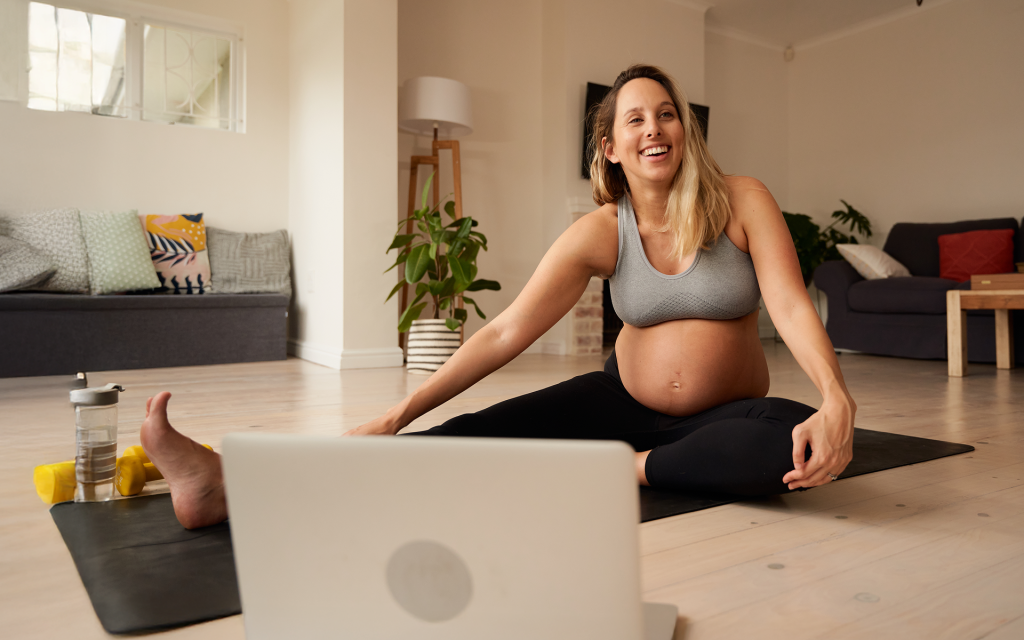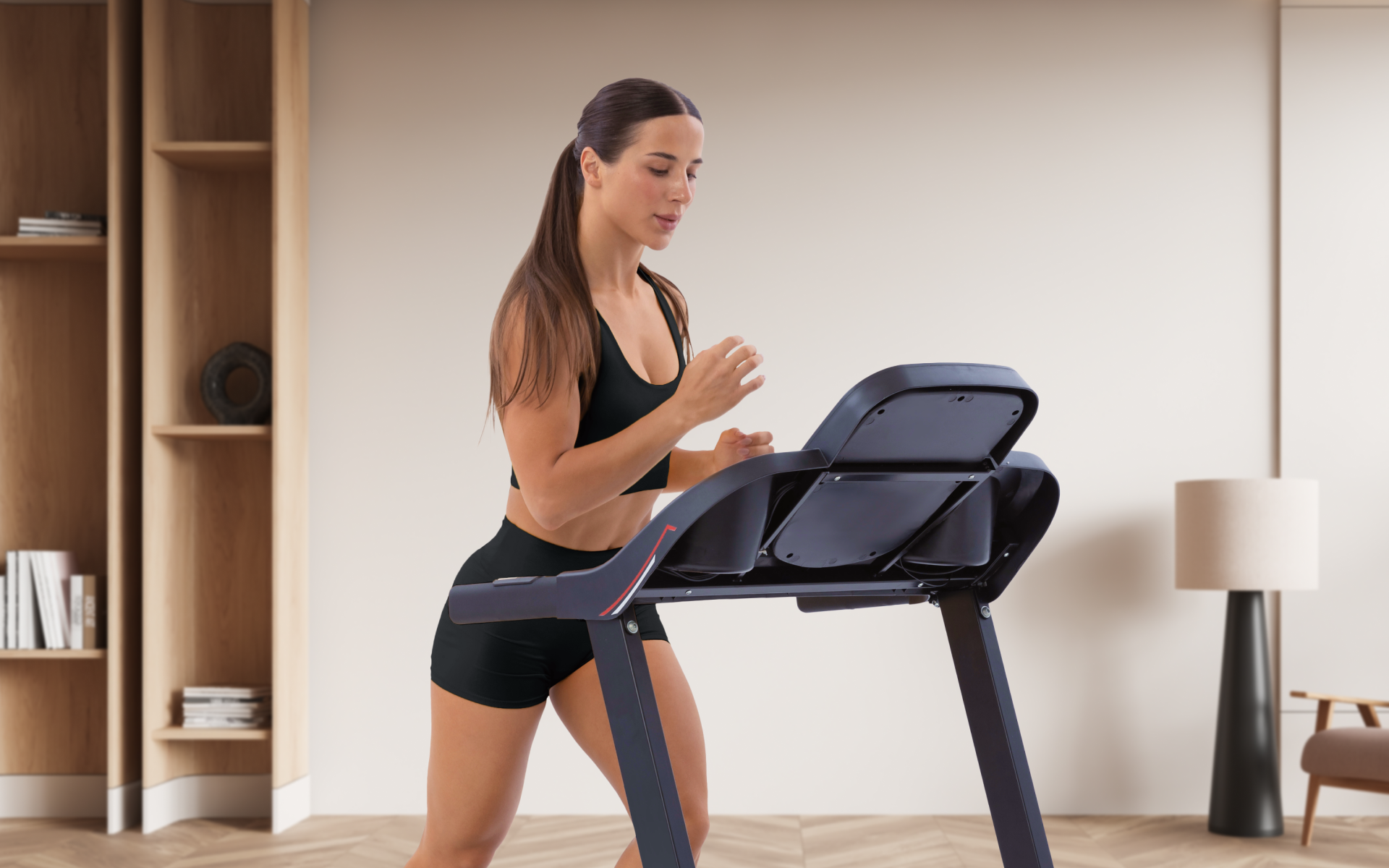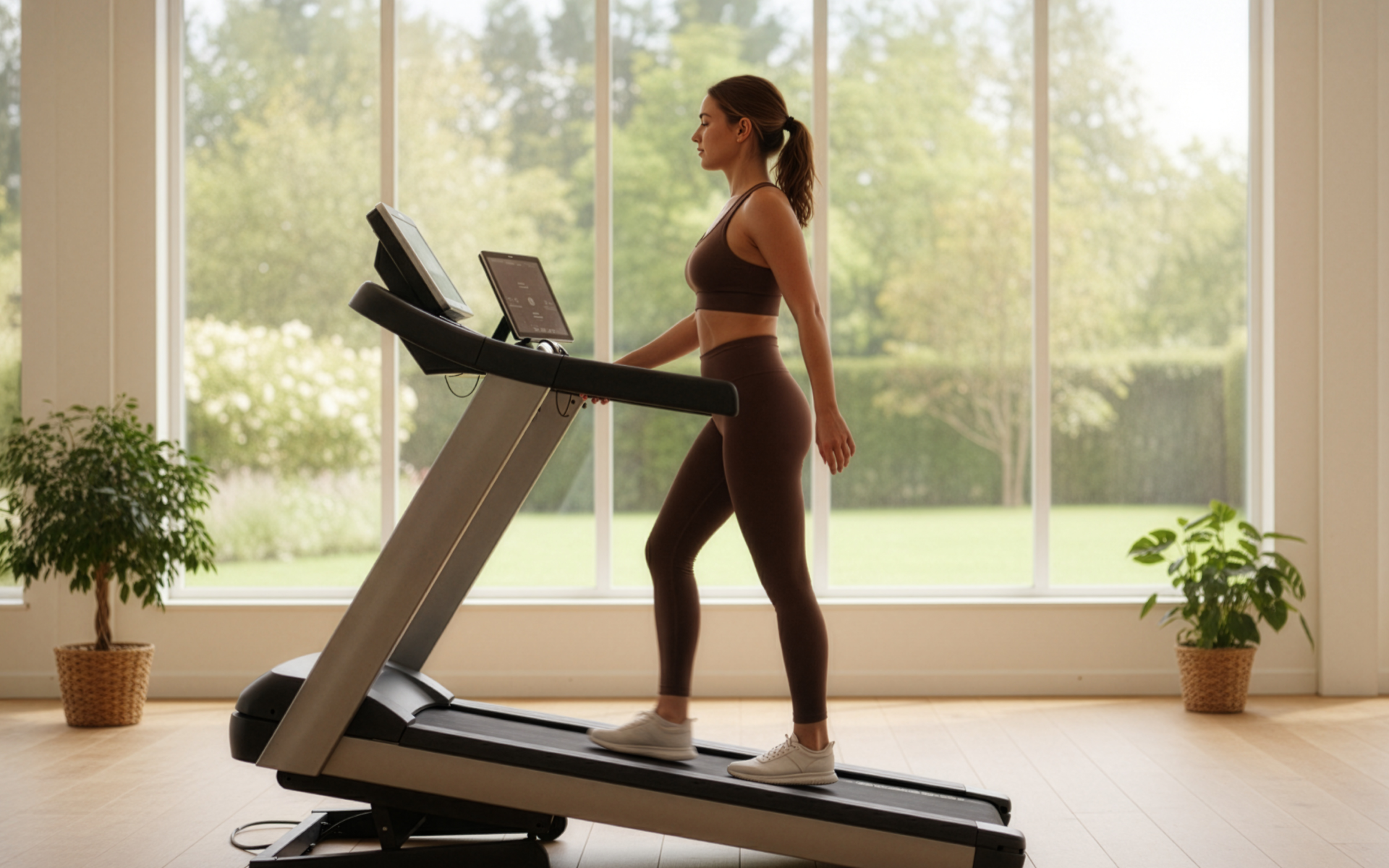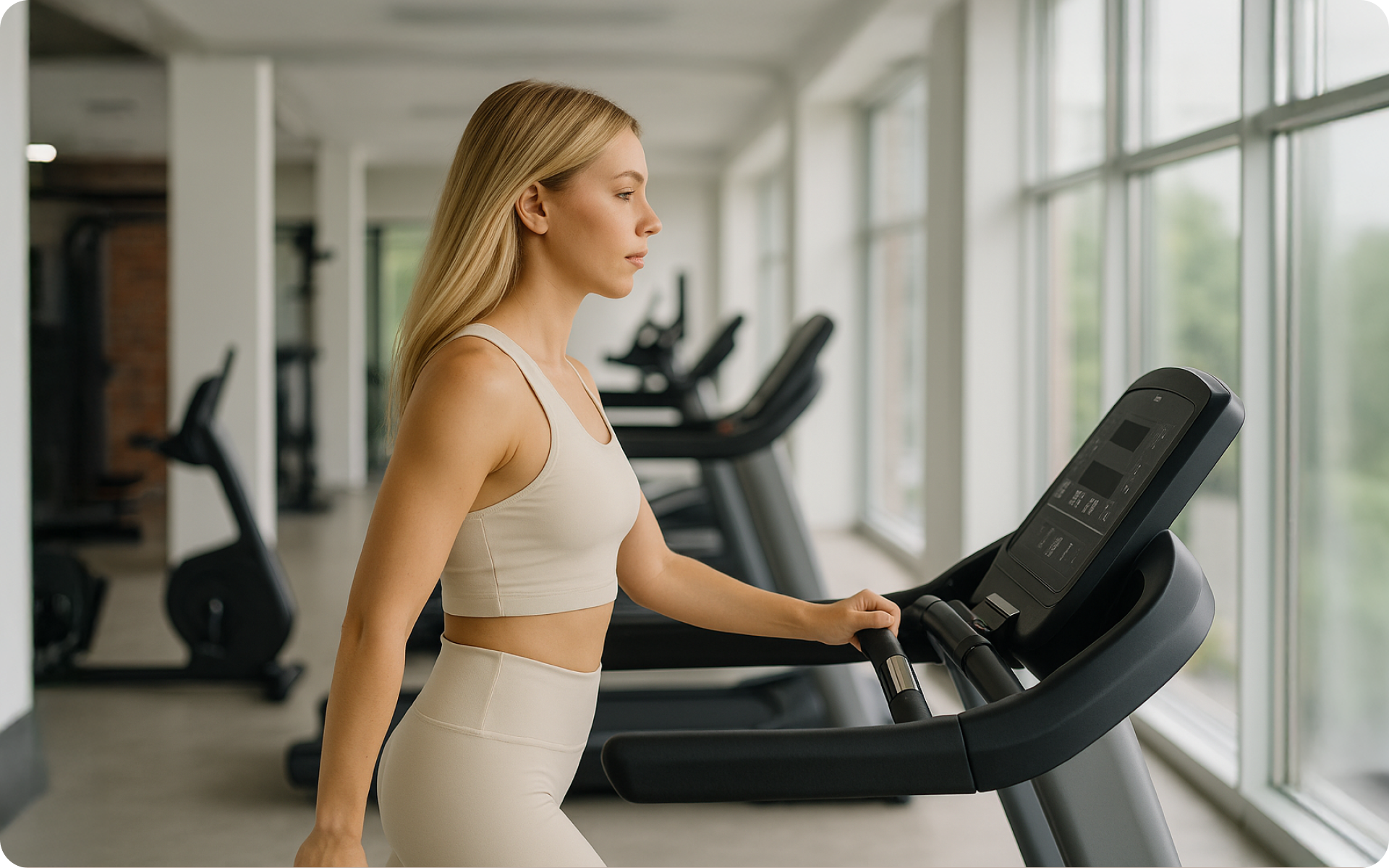Exercise is an important part of any healthy lifestyle, but it becomes even more significant when you’re pregnant. It keeps your body in shape and strengthens your muscles to prepare for labor. You also need to be careful about what type of exercise you do during pregnancy as there are some limitations to consider.
The best way to know if a treadmill workout is safe for you during pregnancy is to consult your doctor. That being said, when you get the go-ahead, here’s some information that may come in handy for crafting the best pregnancy treadmill workout.
Can You Exercise on a Treadmill While Pregnant?
Yes, you can exercise on a treadmill while pregnant.
According to expert advice, aerobic exercises are among the types of workouts that pregnant women are encouraged to engage in. Experts have further stated that as temperature control is essential for pregnant women while exercising, using a treadmill helps provide a safe and protected environment for any pregnant woman to exercise with a reduced risk of overheating (1).
With that being said, please consult your doctor before you engage in a pregnancy cardio workout – or any other exercise for that matter – to ensure that you’re being as safe as can be during this time.
What Are the Possible Benefits of a 30-Minute Pregnancy Treadmill Workout?
According to expert recommendations by the American College of Obstetricians and Gynecologists, women with uncomplicated pregnancies should be encouraged to engage in aerobic and strength-conditioning exercises before, during, and after pregnancy (2).
Experts in the above organization, in addition to those at the Centers for Disease Control and Prevention, go on to state that ideally, pregnant women should get at least 150 minutes of moderate-intensity aerobic activity every week. This usually translates to 30-minute workouts 5 days a week (3, 4).
Using the treadmill is a good way for expectant women to get some much-needed physical activity in their lives. Here are some benefits of walking on a treadmill while pregnant:
-
Reduced Risk of Pregnancy Complications
Cardio exercise performed regularly during pregnancy reduces the risk of gestational hypertension, pre-eclampsia (5). Exercise also reduces the risk of gestational diabetes mellitus (6).
-
Reduced Risk of Delivery Complications
As mentioned above, increased physical activity reduces the risk of gestational diabetes. It should be noted that gestational diabetes isn’t bad for the mother alone – it can affect the baby, which can lead to delivery complications.
Gestational diabetes increases the risk of fetal macrosomia or delivering a larger baby (7, 8). According to research, these bigger babies are more likely to be injured during the birthing process, or worse, they may lose their lives.
The mother also faces complications when delivering a big baby, such as prolonged labor, cesarean delivery, labor augmentation with oxytocins, a prolonged hospital stay, and a higher risk of mortality from coronary heart disease (9).
Research has shown that doing cardio exercise for at least 30 minutes, 3 times per week significantly reduces the frequency of gestational diabetes mellitus in overweight/obese pregnant women, which can reduce the risk of having a larger baby and the aforementioned delivery complications (10).
If you wish to free yourself from all the extra pounds that have been weighing you down for way too long, start using the BetterMe: Health Coaching app and overhaul your entire life!
-
Increased Energy
This is due to an increase in your blood volume (the more you exercise, the better your cardiovascular system gets). You also release endorphins that make you feel happier and provide you with energy (11).
-
Increased Bone Density
Decreases in bone density are a normal part of pregnancy, largely due to a high calcium demand, but also due to hormonal changes (12, 13). Studies on treadmill exercise done on different demographics have shown that such exercise can lead to increased bone strength and improved bone mineral status (14, 15). Expectant mothers with reduced bone density may also experience increased bone strength and density by walking on the treadmill.
-
Relieves Constipation
Constipation is a common issue in pregnancy, particularly in the very early days (16). Thankfully, studies have shown that increased physical activity is a feasible and effective treatment option for those who are dealing with this issue (17, 18). Expectant mothers who are struggling with constipation may benefit from doing a pregnancy treadmill workout routine in the first trimester to reduce constipation.
Check out this article to learn more about pregnancy exercise first trimester safety and tips.
-
Improved Sleep Quality
Research has shown that pregnancy can cause sleep problems and may worsen already existing sleep-related problems. These problems worsen as the pregnancy continues, with the majority of women reporting worsening sleep-related problems during the third trimester (19, 20).
Research has shown that exercise enhances sleep quality and reduces the symptoms of sleep disorders (21, 22). Doing a pregnancy treadmill workout in the third trimester may help these expectant mothers sleep better. Provided they don’t exercise too close to their bedtime, they’re likely to sleep better and wake up more rested.
Take a minute to read this article on exercise ball pregnancy benefits to see how this equipment may help expectant mothers in their third trimester.
Read more: Pregnancy Workout Plan: Safe Exercises For Each Trimester
Treadmill Workout Considerations During Pregnancy
Your body goes through many changes during pregnancy. Your treadmill workout should take these changes into consideration:
- Increased Resting Heart Rate
The growing baby inside your uterus starts to take up space and squeezes on your lungs. The cardiac output during pregnancy increases by about 30 to 50%, which increases your resting heart rate (23). You may notice that you feel short of breath more easily than before and that you bounce when you walk.
- Increased Balance Requirements
Your changing center of gravity can make you feel off balance until your body adjusts. Also, the increased levels of relaxin (a hormone that loosens ligaments and joints for easier delivery) can make you more prone to injuries such as a pulled or strained muscle and arthritis in the future (24).
- Increased Fatigue
You may be tired during your first trimester due to morning sickness or not getting enough sleep at night from waking up to go to the bathroom so many times (25). The fatigue lightens up in the second trimester, but you may have difficulty staying focused. You also tire more easily from standing or walking for too long.
- Increased Dizziness and Light-Headedness
This is usually caused by hormonal changes, which can lower blood pressure or blood sugar levels (26). Make sure to slowly get up from a reclined position, such as in an armchair or bed, and wait a minute or two before standing.
- Increased Swelling and Soreness in the Feet, Legs, and Ankles
The extra weight of the baby places pressure on your feet and legs, which may cause swelling and discomfort (27). During pregnancy, it’s important to stay hydrated by drinking lots of water. This can reduce discomfort, such as swollen feet and ankles.
When to Avoid a Treadmill Workout During Pregnancy
You should avoid strenuous exercise during pregnancy if you experience any of the following symptoms (28):
Fluid Leakage
This occurs when your amniotic sac breaks or has a slow leak (29). You may notice fluid leakage from your vagina or feel a little wet on your clothes. You should contact your doctor if you notice this.
Uterine Contractions
Severe, sudden abdominal pains that come from contractions in the uterus can indicate preterm labor.
Shortness of Breath
Shortness of breath during exercise could indicate a serious condition such as pre-eclampsia, where the mother’s blood pressure rises to an unhealthy level, or a blood clot in your lungs.
Chest Pain
Severe chest pain during exercise could mean you’re having a heart attack and should seek immediate medical attention. It may also indicate a condition such as peripartum cardiomyopathy where the heart muscle is weakened and causes left ventricular dysfunction (30).
Sample 30-Minute Treadmill Workout for Pregnancy
The focus of this workout is on overall health. The most important element is a slow start and moderate progress. It also includes a warm-up and cool-down session. Remember to adjust the workout to suit your fitness level and also pay attention to how you’re feeling at each stage.
- Warm-up: 2.5-3mph and 0-3% incline for 3 minutes.
- Workout: 3.5-4.5mph and 5-15% incline for 25 minutes.
- Cool-down: 2.5mph and 0-3% incline for 2 minutes.
Reasons why BetterMe is a safe bet: a wide range of calorie-blasting workouts, finger-licking recipes, 24/7 support, challenges that’ll keep you on your best game, and that just scratches the surface! Start using our app and watch the magic happen.
Treadmill Workout Tips when Pregnant
The treadmill isn’t off-limits while you’re pregnant. Follow these guidelines to stay safe while enjoying your prenatal cardio workouts:
- Start at a Lower Intensity
Reduce your speed and incline to avoid high-intensity workouts. If you didn’t exercise before getting pregnant, start at a lower intensity than you think is necessary to keep your workout safe. Initially, just walk on the treadmill for 10 to 30 minutes, three days per week (3). As time goes on, you can slowly increase the intensity or the amount of time you spend on the treadmill.
- Use the Talk Test
The talk test is a good way to check the intensity levels when on a treadmill. If you can speak comfortably while exercising, your intensity isn’t high enough for cardio, and it’s time to pick it up a bit. If you can’t get out one or two words without taking a breath, your intensity is good.
- Hold on to Railings for Balance
The combination of the front-loading baby weight and the incline could lead to imbalances while walking or running. Combined with your unstable joints, you could easily fall. Holding onto the rails when exercising on a treadmill helps you maintain balance and stability in your core muscles. If you find yourself hanging on to the rails, you should lower the incline and speed to a more comfortable level.
- Stay Well-Hydrated
Make sure to stay hydrated while exercising on a treadmill. You should drink at least eight glasses of water per day before, during, and after your workout.
- Warm Up and Cool Down
Take the time to warm up and cool down before and after your treadmill workout. This reduces the risk of injury, particularly if you haven’t exercised for a while. Avoid doing intense stretches beforehand as they can cause cramping or discomfort in a pregnant woman’s body. To cool down, walk on the treadmill at a low speed for five to 10 minutes before stepping off.
- Avoid Overheating
Watch for signs of overheating such as excessive sweating, faintness, nausea, dizziness, or muscle cramps. If you experience these symptoms during exercise, stop and rest immediately in a cooler environment such as an air-conditioned room with a fan blowing on you. Let someone know and drink some cold water and sports drinks that contain electrolytes to prevent heat exhaustion or heat stroke if the workout has been intense or lengthy.
Read more: 7-Week Pregnancy Diet: How to Get the Best Nutrition for You and Your Baby
Other Pregnancy-Safe Exercises
The treadmill isn’t your only option if you’re interested in pregnancy exercises. Other workouts you can engage in include (3):
-
Swimming and Water Workouts
The extra weight you’re carrying shouldn’t be an obstacle for swimming workouts. In fact, water workouts are a great way to ease into more demanding workouts as they lessen the stress on your joints and soft tissues.
-
Stationary Bicycling
If heavy impact is a concern, stationary bicycling offers a safe alternative cardiovascular workout during pregnancy. As you can control your intensity with gears and resistance levels, you can start at a low level, increase over time as you feel comfortable, and stop when necessary.
-
Modified Yoga
Yoga poses should be modified or avoided entirely if they cause cramping, dizziness, or nausea throughout your pregnancy. The best yoga poses for pregnant women avoid pressure on the abdomen and any twisting or bending that can feel uncomfortable.
-
Modified Pilates
Pilates is another alternative for pregnancy workouts with modifications to keep it safe and comfortable.
Modifications include avoiding sitting on the mat during abdominal work, using a smaller range of motion for leg exercises such as crunches or hip lifts, and avoiding balancing poses (such as handstands) altogether.
Talk to your doctor about which exercises are best for you during your pregnancy as an individualized approach will ensure you get the best workout possible while staying healthy and safe.
Exercises to Avoid During Pregnancy
The American College of Obstetricians and Gynecologists recommends that you avoid activities that put you at an increased risk of injury, such as the following (3):
-
Contact Sports
High-contact sports such as boxing, football, ice hockey, and soccer pose a risk for injury. You should also avoid activities that have a high fall risk, such as skiing or horseback riding.
-
Hot Yoga or Hot Pilates
Exercise in hot temperatures can lead to dehydration and overheating. You should avoid hot yoga or Pilates during pregnancy as they both increase the risk of injury from fatigue and decreased hydration levels from sweating profusely under increased heat conditions.
-
Aerobics Classes with High-Impact Movements
Avoid high-impact aerobic classes during pregnancy as your joints are more prone to injury while swollen and lubricated with extra synovial fluid (the liquid that is found between your joints). Kickboxing, step aerobics, and other high-impact exercises should be avoided as they place more pressure on your joints.
As mentioned above, pregnant women are recommended to do 30 minutes of exercise a day, 5 days a week (3, 4). If this is too much for you, you could opt to do smaller 10-minute workouts throughout each day. Yes, it can be, as long as you walk at a moderate pace and are consistent with your walking workout. Remember, you can always increase the walking duration as long as you’re okay with it and have the go-ahead from your doctor. Getting in shape while pregnant may not be the best idea. However, you can always improve your health through a good diet and exercise routine. Speak to your health provider so they can find the best dietary and exercise practices that can help you do this without risking you or your baby. Low-intensity exercises such as walking, pregnancy yoga, and other gentle exercises, in addition to Kegel pelvic floor exercises, may help relieve this pressure. Staying hydrated could also help because at times, constipation also causes increased pressure in this area. There is no best month to start exercising while pregnant. You can start at any point, as long as you’ve been cleared to do so by your doctor.Frequently Asked Questions
How long can a pregnant woman walk on a treadmill?
Is walking for 30 minutes a day enough exercise while pregnant?
Can I get in shape while pregnant?
How can you avoid pressure on the cervix during pregnancy?
Which month is best to start exercise during pregnancy?
The Bottom Line
Treadmills aren’t off-limits during pregnancy, but they should be used with caution. When you’re doing a pregnancy treadmill workout, make sure you’re following your doctor’s guidelines, exercising at the right intensity, and keeping yourself well-hydrated throughout your entire workout. Start slowly until you become accustomed to this activity during your pregnancy.
DISCLAIMER:
This article is intended for general informational purposes only and does not serve to address individual circumstances. It is not a substitute for professional advice or help and should not be relied on for making any kind of decision-making. Any action taken as a direct or indirect result of the information in this article is entirely at your own risk and is your sole responsibility.
BetterMe, its content staff, and its medical advisors accept no responsibility for inaccuracies, errors, misstatements, inconsistencies, or omissions and specifically disclaim any liability, loss or risk, personal, professional or otherwise, which may be incurred as a consequence, directly or indirectly, of the use and/or application of any content.
You should always seek the advice of your physician or other qualified health provider with any questions you may have regarding a medical condition or your specific situation. Never disregard professional medical advice or delay seeking it because of BetterMe content. If you suspect or think you may have a medical emergency, call your doctor.
SOURCES:
- Pregnancy And Exercise (2023, ncbi.nlm.nih.gov)
- Physical Activity and Exercise During Pregnancy and the Postpartum Period (2020, acog.org)
- Exercise During Pregnancy (2024, acog.org)
- Pregnant & Postpartum Activity: An Overview (2023, cdc.gov)
- Hypertension in Pregnancy: Executive Summary: Obstetrics & Gynecology (2013, journals.lww.com)
- Exercise during pregnancy and risk of preterm birth in overweight and obese women: a systematic review and meta‐analysis of randomized controlled trials – Magro‐Malosso – 2017 – Acta Obstetricia et Gynecologica Scandinavica – Wiley Online Library (2016, obgyn.onlinelibrary.wiley.com)
- How Gestational Diabetes Can Impact Your Baby (n.d., diabetes.org)
- What Is So Bad About a Big Baby? (2001, diabetesjournals.org)
- Risk factors and obstetric complications of large for gestational age births with adjustments for community effects: results from a new cohort study (2010, pmc.ncbi.nlm.nih.gov)
- A randomized clinical trial of exercise during pregnancy to prevent gestational diabetes mellitus and improve pregnancy outcome in overweight and obese pregnant women (2017, ajog.org)
- Effects of physical activity on maternal plasma beta-endorphin levels and perception of labor pain (1989, pubmed.ncbi.nlm.nih.gov)
- Pregnancy, Breastfeeding, and Bone Health (2023, niams.nih.gov)
- The Effect of Pregnancy on Bone Density and Bone Turnover (2009, onlinelibrary.wiley.com)
- The Effects of Treadmill Exercise Training on Hip Bone Density and Tibial Bone Geometry in Stroke Survivors: A Pilot Study (2010, journals.sagepub.com)
- Treadmill walking exercise modulates bone mineral status and inflammatory cytokines in obese asthmatic patients with long term intake of corticosteroids (2016, pmc.ncbi.nlm.nih.gov)
- Common health problems in pregnancy (2024, nhs.uk)
- Exercise therapy in patients with constipation: a systematic review and meta-analysis of randomized controlled trials (2019, pubmed.ncbi.nlm.nih.gov)
- Diet, Physical Activity, and Chronic Constipation: Unveiling the Combined Effects for Better Treatment Strategies (2024, jnmjournal.org)
- Sleep Problems in Pregnancy—A Cross-Sectional Study in over 7000 Pregnant Women in Poland (2020, pmc.ncbi.nlm.nih.gov)
- Objective and self-reported assessment of sleep quality during each trimester of pregnancy: A prospective observational study (2024, sciencedirect.com)
- The Effect of Physical Activity on Sleep Quality and Sleep Disorder: A Systematic Review (2023, pmc.ncbi.nlm.nih.gov)
- The impact of exercise on sleep and sleep disorders (2025, nature.com)
- Physical Changes During Pregnancy (2024, msdmanuals.com)
- The effect of relaxin on the musculoskeletal system (2014, onlinelibrary.wiley.com)
- Tiredness and sleep problems – Pregnancy (2024, nhs.uk)
- Dizziness during pregnancy: When is it a concern? (2024, heart.org)
- Swollen ankles, feet and fingers in pregnancy (2024, nhs.uk)
- Exercise in Pregnancy and the Postpartum Period (2003, sciencedirect.com)
- [Amniotic fluid leakage and premature rupture of membranes after amniocentesis. A review of the literature] (2000, pubmed.ncbi.nlm.nih.gov)
- Peripartum Cardiomyopathy (2016, ahajournals.org)










